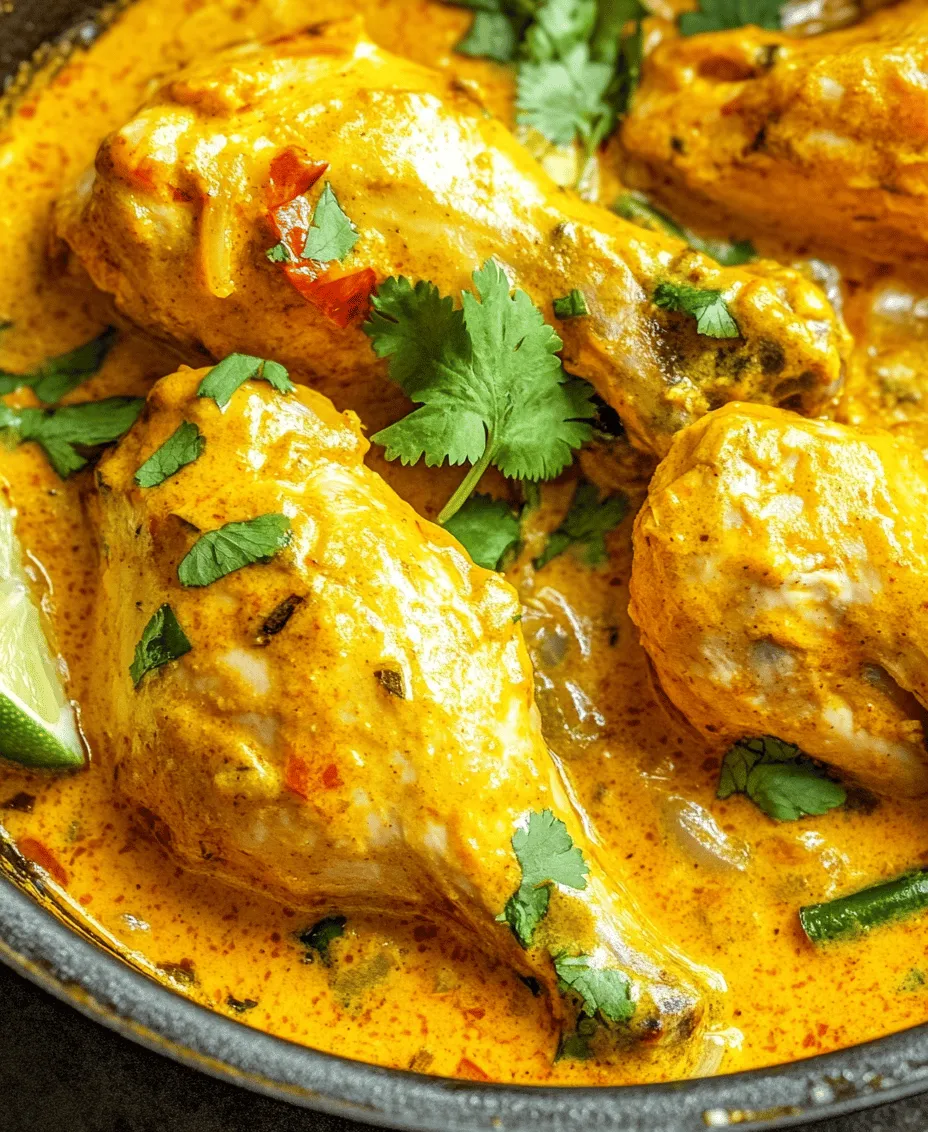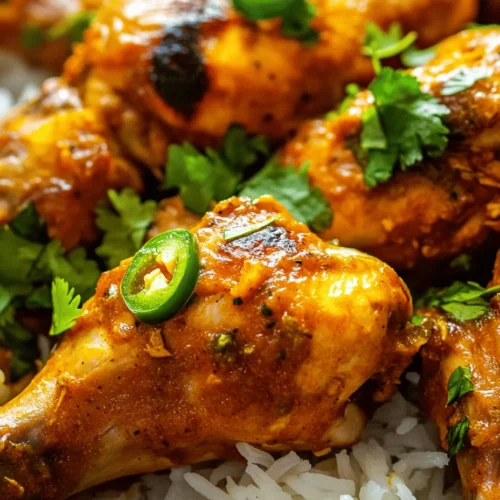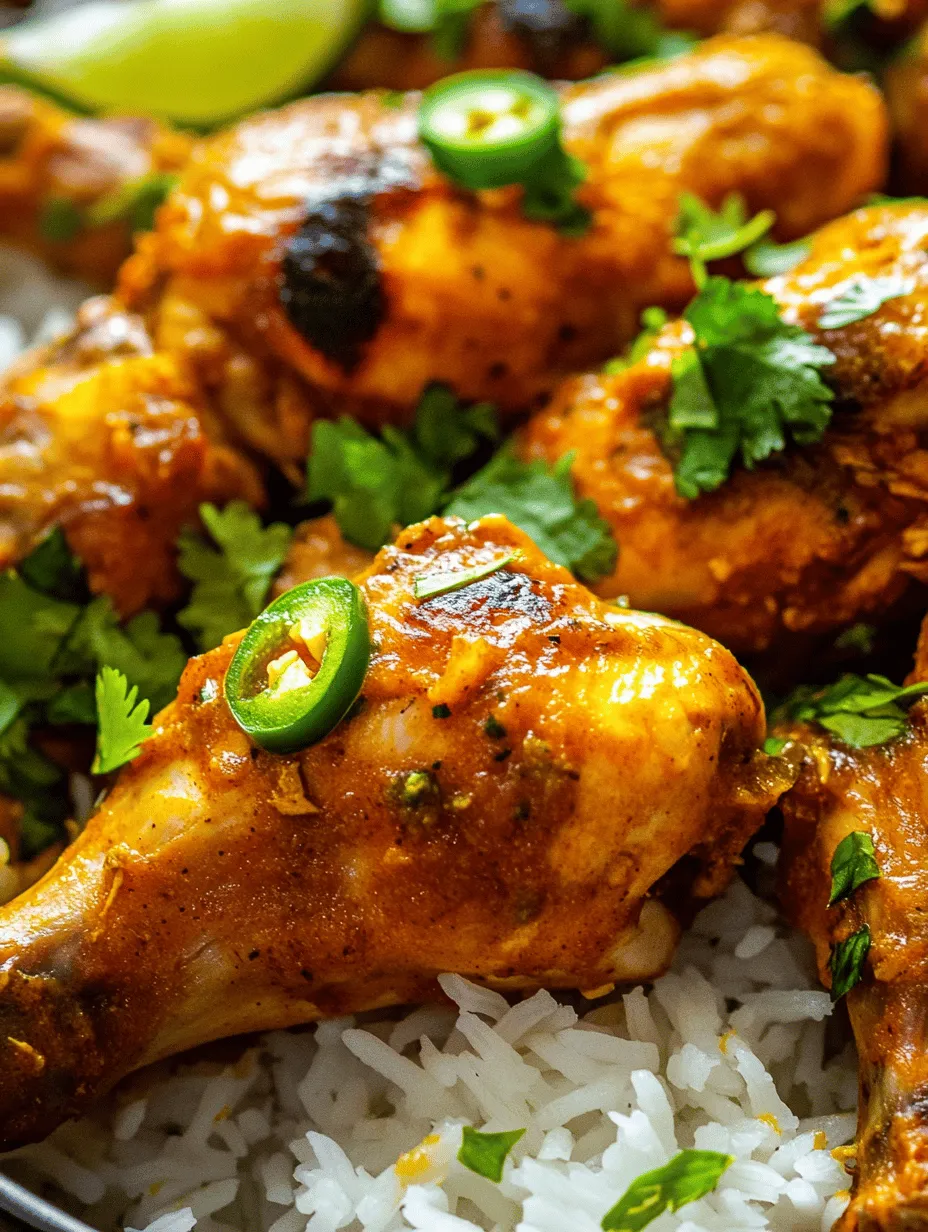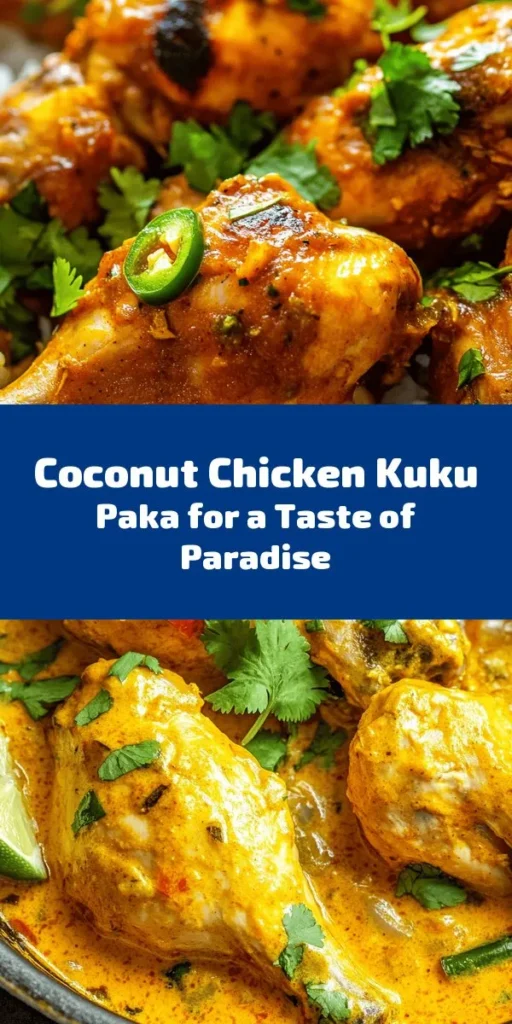Introduction
Kuku Paka is not just a dish; it is a celebration of culinary heritage that has its roots in East African cuisine, particularly within the coastal regions of Kenya and Tanzania. Renowned for its vibrant flavors and aromatic spices, this coconut chicken curry embodies a fusion of cultural influences, making it a beloved staple for families and communities alike. The combination of tender chicken simmered in a rich coconut milk sauce, coupled with a medley of spices and fresh ingredients, creates a dish that is both comforting and exotic.
The appeal of Kuku Paka extends beyond its delectable taste; it is a dish often served during gatherings and festive occasions, symbolizing hospitality and togetherness. Whether enjoyed at a family dinner or shared among friends during a celebration, Kuku Paka brings people together around the table, fostering a sense of community and connection through food. As we explore this recipe, you will learn how to create your own Kuku Paka Delight, a dish that promises to tantalize your taste buds and warm your heart.
Understanding the Ingredients
To create an authentic Kuku Paka, it is essential to understand the key ingredients that contribute to the dish’s unique flavor profile. Each component plays a vital role in crafting a rich and satisfying meal.
Whole Chicken
The foundation of Kuku Paka is undoubtedly the chicken. Using a whole chicken is traditional, as it allows for a variety of cuts that cook evenly and offer a range of textures. Opting for fresh, quality meat is crucial, as it enhances the dish’s overall flavor. When selecting your chicken, look for a bird that is free-range or organic, if possible, to ensure the best taste and health benefits. The chicken is typically cut into pieces, which allows for better marination and absorption of flavors during cooking.
Coconut Milk
Coconut milk is the star of Kuku Paka, providing a creamy base that enriches the curry. Its natural sweetness balances the spices and adds a depth of flavor that is both soothing and indulgent. When choosing coconut milk, select a brand that is free from additives for the most authentic taste. You may also consider using freshly grated coconut for an even more intense flavor. The richness of coconut milk not only enhances the dish but also lends a tropical essence that is characteristic of East African cuisine.
Aromatics
Aromatic ingredients such as onions, garlic, and ginger are fundamental to building a robust flavor base for Kuku Paka. Onions, when sautéed to a golden brown, develop sweetness that forms the backbone of the curry. Garlic and ginger add a warm, pungent note that complements the coconut milk and spices beautifully. Together, they create a fragrant aroma that is irresistible and sets the stage for the rest of the dish.
Spices
The spice blend used in Kuku Paka is essential for achieving its signature flavor profile. Turmeric, cumin, coriander, and paprika are the most common spices found in this dish.
– Turmeric: Known for its vibrant yellow color and earthy flavor, turmeric is a key ingredient that not only adds visual appeal but also brings a subtle bitterness that balances the creaminess of the coconut milk.
– Cumin: With its warm, nutty taste, cumin lends depth and complexity to the curry. It is often used in various dishes across East African and Indian cuisines, making it a familiar flavor in Kuku Paka.
– Coriander: Ground coriander provides a citrusy undertone that brightens the dish. Its sweet and slightly floral notes enhance the overall flavor without overpowering the other ingredients.
– Paprika: This spice adds a mild heat and a smoky flavor, contributing to the curry’s complexity. Smoked paprika can be used for an added depth, while sweet paprika can be chosen for a milder taste.
Fresh Elements
To balance the richness of the coconut milk and spices, fresh ingredients such as tomatoes, green chilies, and cilantro are incorporated into Kuku Paka.
– Tomatoes: Fresh, ripe tomatoes add acidity and sweetness, brightening the dish and helping to create a well-rounded sauce. They also contribute to the curry’s texture, making it more hearty and satisfying.
– Green Chilies: For those who enjoy a bit of heat, green chilies are essential. They can be adjusted based on personal preference, allowing the dish to be mild or spicy, depending on the audience.
– Cilantro: Fresh cilantro adds a burst of color and a refreshing herbal note that complements the flavors of the dish. It is often used as a garnish, adding a final touch of brightness before serving.
Preparing the Chicken
Marinating the chicken is an essential step in creating a flavorful Kuku Paka. The marination process allows the chicken to absorb the spices, enhancing its taste and tenderness. Here’s how to effectively prepare the chicken for your curry.
Marination Process and Its Importance
Begin by cutting the whole chicken into manageable pieces, ensuring that the cuts are even for uniform cooking. This can be done by separating the thighs, drumsticks, and breasts. Once cut, the chicken should be placed in a large bowl.
Next, prepare a marinade using a blend of spices, garlic, ginger, and a bit of salt. A typical marinade might include:
– 1 tablespoon of turmeric
– 1 tablespoon of cumin
– 1 tablespoon of coriander
– 1 teaspoon of paprika
– 4 cloves of minced garlic
– 2 inches of grated ginger
– Salt to taste
– Juice of one lemon (to tenderize)
Mix all ingredients into a paste and thoroughly coat each piece of chicken. The acidity of the lemon juice not only enhances the flavor but also helps to tenderize the meat, ensuring it remains juicy during cooking.
Suggested Marination Times for Optimal Results
For best results, allow the chicken to marinate for at least 1 hour. However, if you have the time, marinating overnight in the refrigerator will yield even more flavorful results, as the chicken will absorb the spices more deeply. If marinating for an extended period, be mindful to keep the chicken well-covered to prevent contamination and drying out.
Techniques for Cutting and Handling Chicken Safely
When handling raw chicken, it’s crucial to maintain food safety practices. Use a sharp knife and a clean cutting board dedicated to raw meat to prevent cross-contamination. Always wash your hands, cutting boards, and utensils thoroughly with soap and hot water after coming into contact with raw chicken.
If you are unsure about how to cut a whole chicken, consider watching instructional videos or consulting a culinary guide. Practicing safe and efficient cutting techniques will not only enhance your cooking skills but also ensure a safe cooking environment.
Creating the Flavorful Sauce
Once the chicken has marinated, the next step is to create the sauce that will envelop the chicken and bring the dish to life. The sauce is where the magic happens, transforming simple ingredients into a mouthwatering coconut chicken curry.
Step-by-Step Guide on Sautéing Onions
Begin by heating a generous amount of oil or ghee in a large pot over medium heat. Once the oil is hot, add finely chopped onions. The goal here is to sauté the onions until they turn golden brown, which typically takes around 8-10 minutes. Stir occasionally to prevent burning and ensure even cooking. The caramelization of the onions will enhance their sweetness, which is essential for balancing the dish’s flavors.
The Art of Balancing Flavors with Aromatics
After the onions are perfectly sautéed, it’s time to introduce the minced garlic and grated ginger. Adding them at this stage allows their flavors to bloom, infusing the oil with their aromatic qualities. Sauté for an additional 2-3 minutes until fragrant, being careful not to let them burn, as burnt garlic can impart a bitter taste to the curry.
Incorporating Tomatoes and Chilies
Next, add the chopped tomatoes and sliced green chilies to the pot. The tomatoes should be cooked down until they break apart and meld into the sauce, which can take about 5-7 minutes. This step is crucial for creating a cohesive sauce that will envelop the chicken. As the tomatoes cook, they release their juices, which will combine with the sautéed onions, garlic, and ginger to form a rich base.
Stir in the marinated chicken pieces, ensuring they are well-coated with the sauce. Allow the chicken to cook for a few minutes, letting it absorb the flavors before introducing the coconut milk.
Cooking the Chicken to Perfection
Once the sauce is well-prepared and the chicken is incorporated, it’s time to cook everything together. This is where the flavors meld and the chicken becomes tender and infused with the rich essence of coconut and spices.
Continue by pouring in the coconut milk, stirring gently to combine. Allow the mixture to come to a simmer, then reduce the heat to low. Cover the pot partially to retain moisture while enabling some evaporation, which concentrates the flavors.
Simmer the chicken for about 30-40 minutes, or until it is cooked through and tender. Stir occasionally to ensure even cooking and prevent the sauce from sticking to the bottom of the pot. Adjust the seasoning as needed, adding salt or additional spices to taste.
As the Kuku Paka simmers, the tantalizing aroma will fill your kitchen, inviting your family and friends to gather around for a delightful meal.
In this initial part of the article, we have laid the groundwork for creating a delicious and authentic Kuku Paka Delight. By understanding the ingredients, preparing the chicken properly, and crafting a flavorful sauce, you are well on your way to mastering this exquisite dish. Stay tuned for the next installment, where we will delve into the finishing touches and serving suggestions to make your Kuku Paka truly unforgettable.

Methods to Ensure Even Cooking and Flavor Distribution
To achieve the perfect Kuku Paka Delight, attention to cooking techniques plays a vital role. Begin by ensuring that the chicken pieces are cut into uniform sizes; this allows for even cooking throughout the dish. Larger pieces will take longer to cook than smaller ones, so aim for a consistent size—about 2 to 3 inches for optimal results.
Before placing the chicken in the pan, season it with a blend of spices to enhance flavor. A combination of salt, pepper, and the spices used in the Kuku Paka recipe should be well-distributed across the chicken. This not only improves the flavor but also aids in the browning process that is crucial for this dish.
Importance of Browning the Chicken Before Simmering in Coconut Milk
Browning the chicken before simmering it in coconut milk is a key step that contributes to the depth of flavor in Kuku Paka. When you sear the chicken in hot oil, the Maillard reaction occurs, creating a caramelized crust that adds a rich, savory taste to the dish. This step should not be overlooked; it enhances the overall complexity of flavors and provides a beautiful golden color to the dish.
To effectively brown the chicken, heat your oil in a large pan or Dutch oven over medium-high heat. Once the oil is hot, add the chicken pieces in batches to avoid overcrowding. Cook each side for about 4-5 minutes until they are golden brown before transferring them to a plate. This technique not only improves flavor but also seals in the juices, keeping the chicken moist during the simmering stage.
Techniques for Monitoring the Cooking Process to Avoid Overcooking
Monitoring the cooking process is essential to ensure that your chicken remains juicy and tender. After adding the coconut milk and simmering the chicken, keep a close eye on the heat level. A gentle simmer is ideal—too high of a heat can cause the chicken to become tough and dry. Aim for a temperature where small bubbles rise to the surface but do not boil vigorously.
Use a meat thermometer to check for doneness; the internal temperature of the chicken should reach 165°F (75°C). If you don’t have a thermometer, cut into a piece of chicken to check. The meat should be opaque and the juices should run clear. If the chicken is cooked too early, you can keep it warm by covering it with a lid until the sauce is ready.
Simmering and Adjusting the Sauce
Explanation of Simmering as a Cooking Technique to Meld Flavors
Simmering is an essential technique in the Kuku Paka recipe, allowing the flavors of the spices and coconut milk to meld beautifully. When you simmer, the ingredients cook slowly and gently, which facilitates the infusion of flavors without the risk of burning or sticking to the bottom of the pan. This method also allows the chicken to absorb the creamy, aromatic sauce fully, ensuring that every bite is rich in flavor.
Once the chicken is browned and you’ve added the coconut milk, lower the heat to maintain a simmer. Cover the pan with a lid to trap moisture and heat, cooking for about 20-30 minutes. Stir occasionally to ensure nothing sticks to the bottom and to promote even cooking.
Tips on Adjusting the Sauce Consistency and Seasoning to Personal Taste
As the Kuku Paka simmers, you may find that the sauce needs adjustments for both consistency and seasoning. If the sauce appears too thick, you can add a bit of water or chicken stock to reach your desired consistency. Conversely, if it’s too thin, remove the lid and let it simmer uncovered for a few more minutes to allow it to reduce and thicken.
Seasoning is also critical in achieving the perfect balance of flavors. Taste the sauce before serving, and adjust as necessary. You might want to add more salt, a touch of sugar to counteract acidity, or additional spices for heat or depth. It’s your dish, so feel free to experiment until it meets your taste preferences.
The Role of Lime Juice in Balancing Flavors and Enhancing Freshness
Lime juice is a magical ingredient in Kuku Paka, providing a burst of acidity that brightens the dish and balances the richness of the coconut milk. Adding lime juice towards the end of the cooking process preserves its fresh flavor and prevents it from becoming bitter from prolonged heat. A tablespoon or two is usually sufficient, but adjust based on your preference.
After removing the dish from the heat, squeeze fresh lime juice over the top just before serving. This final touch not only enhances flavor but also adds a refreshing aroma that complements the spices in the dish.
Optional Grilling for Added Flavor
Discussing the Benefits of Grilling or Broiling the Chicken in Banana Leaves
For those looking to elevate their Kuku Paka Delight, grilling or broiling the chicken in banana leaves can impart a unique smoky flavor that takes this dish to the next level. Banana leaves are traditional in many tropical cuisines, providing a natural wrapper that helps retain moisture while infusing the chicken with subtle earthy notes.
Grilling the chicken over an open flame can create a charred exterior while keeping the inside juicy. If you prefer to use your oven, broiling is an excellent alternative that mimics the grilling effect, providing a caramelized surface that enhances the overall taste and presentation of the dish.
Instructions for Grilling to Achieve a Smoky, Charred Finish
To grill the chicken, start by marinating it in the coconut milk and spices for at least an hour, or overnight if time allows. Once marinated, wrap the chicken pieces in banana leaves (or aluminum foil if banana leaves are unavailable) and place them on a preheated grill. Cook for about 15-20 minutes per side, depending on the thickness of the chicken pieces. The key is to watch for the internal temperature to reach 165°F (75°C).
If using a broiler, place the wrapped chicken on a baking sheet and broil for about 5-7 minutes per side, checking frequently to avoid burning. This method still allows for the smokiness to develop while ensuring the chicken cooks evenly.
Alternative Methods for Those Without Access to Grilling Equipment
If you don’t have a grill or broiler, don’t worry—you can still achieve amazing flavor. Simply pan-sear the chicken in a cast-iron skillet for a few minutes on each side to create a nice crust before finishing it with the coconut milk in the same pan. This method allows you to capture all the delicious browned bits left in the skillet, adding depth to your sauce.
Another option is to roast the chicken in the oven at 400°F (200°C) for about 30-40 minutes. This cooking method will also yield a deliciously crispy exterior while keeping the inside moist.
Serving Suggestions
Best Practices for Serving Kuku Paka: Ideal Accompaniments Like Rice, Chapati, or Ugali
Kuku Paka is a versatile dish that pairs beautifully with a variety of sides. Traditional accompaniments include steamed rice, which absorbs the rich coconut sauce, or chapati, an unleavened flatbread perfect for scooping up the chicken and sauce. Ugali, a popular staple made from maize flour, is another excellent choice that complements the dish’s flavors.
When serving, consider presenting the chicken pieces atop a bed of rice or alongside a warm chapati. Generously spoon the sauce over the chicken and rice to enhance the visual appeal and ensure each bite is packed with flavor.
Presentation Tips for an Appealing Dish That Highlights the Vibrant Colors and Textures
Presentation can elevate your Kuku Paka from a home-cooked meal to a feast for the eyes. Start by choosing a wide, shallow platter to showcase the dish. Arrange the chicken pieces in a circular pattern, allowing the vibrant orange and yellow hues of the coconut sauce to spill around it. Garnish with freshly chopped cilantro or parsley for a pop of color and added freshness.
Consider adding slices of lime or lemon around the dish for an inviting touch. This not only enhances the visual appeal but invites diners to add a squeeze of citrus to their servings.
Discussion on Cultural Practices Around Serving and Enjoying This Dish in Communal Settings
Kuku Paka is often enjoyed in communal settings, reflecting the cultural significance of sharing meals. In many East African communities, it’s common to serve dishes family-style, where everyone gathers around a large platter. This encourages interaction and connection, making the meal an event rather than just sustenance.
Encourage guests to serve themselves and customize their plates with desired sides and condiments. It’s a wonderful way to foster a sense of togetherness and warmth, characteristic of the culinary traditions that Kuku Paka represents.
Nutritional Benefits of Kuku Paka
Breakdown of Nutritional Aspects of the Main Ingredients
Kuku Paka is not only flavorful but also packed with nutrition. The primary ingredients—chicken, coconut milk, and spices—offer a range of health benefits. Chicken is an excellent source of lean protein, essential for muscle repair and growth. Coconut milk, while rich and creamy, provides healthy fats that can support heart health and provide sustained energy.
The spices used in Kuku Paka, like turmeric, ginger, and garlic, are known for their anti-inflammatory properties and antioxidant benefits. They can aid digestion and boost the immune system, making this dish both delicious and nourishing.
Health Benefits Associated with Coconut Milk and Spices Used in the Recipe
Coconut milk, a key ingredient in Kuku Paka, is rich in medium-chain triglycerides (MCTs), which are linked to various health benefits, including improved metabolism and weight management. Additionally, the lauric acid found in coconut milk has antimicrobial properties that can help combat infections.
The spices commonly used in this recipe—cumin, coriander, and turmeric—are not just for flavor; they also contribute to health. Turmeric, for example, contains curcumin, a compound with powerful anti-inflammatory and antioxidant effects. Incorporating these spices can enhance overall health while adding layers of flavor to your dish.
Consideration for Dietary Preferences and Alternatives
Kuku Paka can easily be adapted for various dietary preferences. For those who prefer a vegetarian option, substitute the chicken with tofu or a medley of vegetables like bell peppers, carrots, and eggplant. Ensure to adjust the cooking time accordingly to avoid overcooking your plant-based ingredients.
For those who require gluten-free options, serve Kuku Paka with rice or gluten-free flatbreads. The dish is naturally gluten-free, making it suitable for a wide range of dietary needs.
Conclusion
In creating Kuku Paka Delight, you’ve embarked on a culinary journey that beautifully showcases the richness of East African flavors and traditions. From the initial browning of the chicken to the careful simmering of the coconut sauce, each step is a testament to the importance of technique in achieving a delicious outcome.
This dish is not just a meal; it embodies a cultural heritage of communal enjoyment and shared experiences. As you gather around the table with friends and family, savoring the aromatic flavors and vibrant presentation, you’re partaking in a tradition that has brought people together for generations.
We encourage you to try making Kuku Paka, share your experiences, and perhaps even put your unique spin on this delightful recipe. Whether enjoyed on a quiet evening or at a lively gathering, Kuku Paka is sure to impress and satisfy, inviting everyone to indulge in its creamy, spicy goodness.



